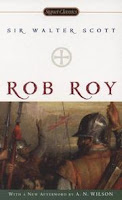Modern historical fiction is quite well-appreciated and well-sold both among male and female readers. There's been a huge spreading of best- selling authors and series in the latest years. But where does this genre come from, actually? The Father of the Historical Novel was Sir Walter Scott ( 1771 - 1832 ) who started the publication of a long series of successful volumes to pay back his debts with Waverley (1814). The story takes place between Scotland and England in the years just before the first Jacobite Uprising (1715) and features both historical and fictional characters involved in historical and fictional event . The prototype for hugely successful Gabaldon's Outlander saga? Surely it was. Of that one and many more.
Among the works of Sir Walter Scott, Ivanhoe (1819) is maybe his most widely - known and studied novel. The almost forgotten one I want to remind you about today is Rob Roy (1817) in which Scott used Scottish history again after Waverley.
The Rob Roy (1671-1734) of the title really lived: he was involved in one of the 1715 Jacobite Uprising against the British monarch and he was a famous outlaw. As he usually did, Scott chose certain parts of his actual biography and combined them with things he invented. Interestingly, Rob Roy is not the main character in the book: a young poet named Frank Osbaldistone is. It seems Scott's editor thought that "Rob Roy" was a much more exciting title for a book than "Frank Osbaldistone".
Rob Roy's role in this tale is not primarily but indispensable, and you come away from the book feeling that Rob Roy is the central figure, even though he does not even make an appearance until halfway through the story. Consequently, it is not surprising that Rob Roy played a huge role in making Robert Roy MacGregor a household name throughout the world. As a matter of fact, Rob Roy fought valiantly during the uprising, and for a time, after the uprising was put down, lived a rather tranquil life as a cattle baron who acquired his herd primarily by theft (which wasn't exactly illegal at the time, but that is another story). A quiet country life was not to be for Rob Roy, and he was soon branned as an outlaw, and he spent most of his life fighting against what he saw as the injustices done to his family, and himself. In many regards, MacGregor was the Scottish equivalent of Robin Hood, and like the legendary English hero, he has been heralded in song, legend, and literature.
The plot of Scott's book has been criticised as "disjointed" but Robert Louis Stevenson, however, who loved it from childhood, regarded "Rob Roy" as the best novel of the greatest of all novelists.
A 1995 film starring Liam Neeson and Jessica Lange focuses on the life and adventures of Rob Roy. I remembered watching it in the "Braveheart vogue" years and finding it good and less hard to watch than Mel Gibson's epic Scottish movie.
Rob Roy the movie is not based on Scott's novel, actually, but on the Scottish outlaw's real biography.
The film was shot entirely on location in Scotland, much of it in parts of the Highlands so remote they had to be reached by helicopter. Glen Coe, Glen Nevis, and Glen Tarbert can be seen. In the opening scenes, Rob and his men pass by Loch Leven. Loch Morar stood in for Loch Lomond, on the banks of which the real Rob Roy lived.
A number of impressive Scottish castles were also used as setting: Castle Tioram, Drummond Castle, Megginch Castle and Crichton Castle .




0 comments:
Post a Comment